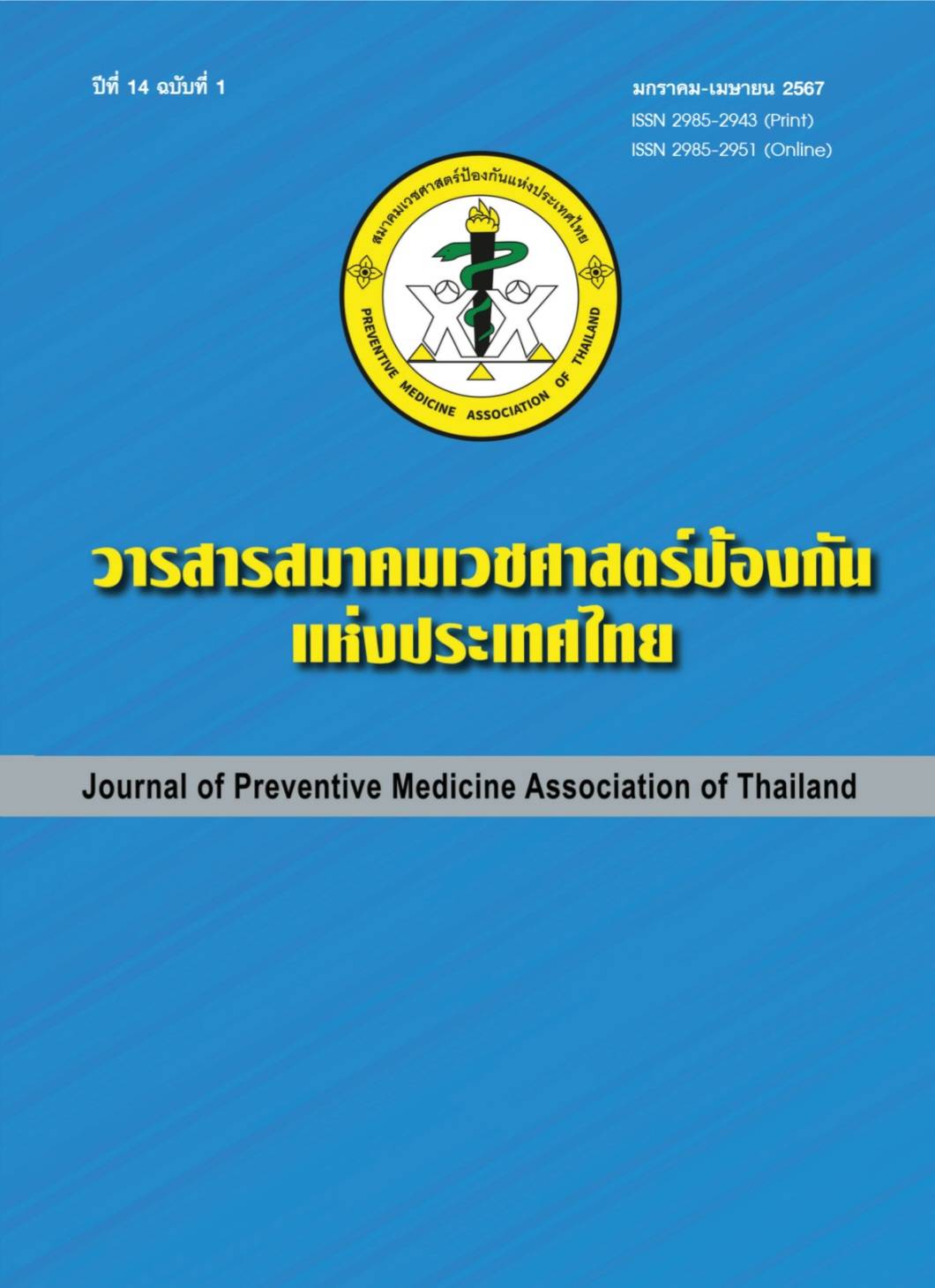Development of a Nursing Service Model for Stroke Patients in Bueng Kan Hospital
Keywords:
stroke patients, Bueng Kan HospitalAbstract
Objectives: 1) To develop a nursing service model for stroke patients in Bueng Kan Hospital. 2) To evaluate the outcomes of the nursing service model for stroke patients in terms of: 1) service providers, 2) quality, and 3) service users. Methods: This was a research and development (R&D) study. Data were collected between July 20, 2023 and January 31, 2024. The samples were: 1) stroke patients admitted to Bueng Kan Hospital between November 1, 2023 and January 31, 2024, and 2) 74 professional nurses working in the care of stroke patients in the male medical ward (12 nurses), female medical ward (12 nurses), male surgical ward (12 nurses), female surgical ward (12 nurses), special ward (9 nurses), and intensive care unit (17 nurses). The research instruments were: 1) a questionnaire on the nursing service situation for stroke patients, 2) an evaluation form for the nursing service model for stroke patients in Bueng Kan Hospital, 3) the nursing model for stroke patients in Bueng Kan Hospital, 4) a knowledge assessment form for professional nurses on stroke nursing, 5) a satisfaction assessment form for professional nurses on the nursing model for stroke patients in Bueng Kan Hospital, 6) a record form for compliance with the nursing service model for stroke patients in Bueng Kan Hospital, 7) a data record form for stroke patients with ischemic stroke, 8) the Barthel Index (BI-ADL) for assessing the ability to perform daily activities, and 9) a satisfaction assessment form for patients/caregivers on the nursing practice guidelines for stroke patients in Bueng Kan Hospital. Descriptive statistics and Paired Samples t-test were used for data analysis. Results: The nursing service model for stroke patients in Bueng Kan Hospital consisted of 2 components: 1) Guidelines for the administration of nursing workforce for stroke patient care. 2) Nursing practice guidelines for stroke patients. The evaluation of the nursing service model for stroke patients showed that: 1) The knowledge of professional nurses about stroke nursing after using the nursing service model for stroke patients had a mean score increase and was statistically significant (p<.005). 2) The level of satisfaction with the nursing model for stroke patients in Bueng Kan Hospital was at a very satisfied level (60.8%), followed by the most satisfied level (35.1%). The overall mean score was 3.98. 3) Compliance with the nursing practice guidelines for stroke patients showed that all 7 activities of the nursing practice guidelines for stroke patients were highly practiced. The overall mean score was 13.5. 4) Compliance with the guidelines for the administration of nursing workforce for stroke patient care showed that all 7 activities of the guidelines for the administration of nursing workforce for stroke patient care were highly practiced. The overall mean score was 13.8. 5) No complications of increased intracranial pressure, pressure sores, and pneumonia were found after using the nursing model for stroke patients. The incidence of urinary tract infection was 1.70%. The average length of stay was 4.8 days. 6) The level of ability to perform daily activities (BI-ADL) before discharge was higher than that at admission. 7) The satisfaction of patients/caregivers with the nursing practice guidelines for stroke patients had an overall mean score of 3.93, which was at a very satisfied level (62.3%), followed by the most satisfied level (20.8%). Conclusion: The nursing service model for stroke patients in Bueng Kan Hospital, which was developed, resulted in high satisfaction of service users and a reduction in complications. Service providers had increased knowledge and high satisfaction.
References
สำนักโรคไม่ติดต่อ กรมควบคุมโรค. ชุดรูปแบบบริการในการป้องกัน ควบคุมโรคหลอดเลือดหัวใจ โรคหลอดเลือด สมองและโรคไตเรื้อรัง สำหรับสถานบริการ. นนทบุรี: สำนักโรคไม่ติดต่อ กรมควบคุมโรค; 2560.
Kalra L, Langhorne P. Facilitating recovery: evidence for organized stroke care. J Rehabil Med 2007;39(2):97-102.
สำนักงานปลัดกระทรวงสาธารณสุข. สถิติสาธารณสุข [อินเทอร์เน็ต]. 2560 [เข้าถึงเมื่อ 9 เม.ย. 2566] เข้าได้จาก: http://bps.moph.go.th/new_bps/sites/default/files/.
โรงพยาบาลบึงกาฬ. ข้อมูลรายงานโรคหลอดเลือดสมอง พ.ศ.2563-2565. บึงกาฬ: โรงพยาบาลบึงกาฬ; 2566.
Sullivan EJ, Decker PJ. Effective leadership management nursing. 6thed. New Jersey: Prentice-Hall; 2005. p.24.
นริสา วงศ์พนารักษ์. ทฤษฎีการพยาบาลของคิง: แนวคิดและการประยุกต์ใช้ในการพยาบาล. วารสารสมาคมพยาบาลฯ สาขาภาคตะวันออกเฉียงเหนือ 2556;31(4):16-25.
King IM. King’s theory of goal attainment. Nurs Sci Q 1992;5(1):9-25.
แสงระวี มณีวรรณ, อาภาพร เผ่าวัฒนา, วีณา เที่ยงธรรม, ยงชัย นิละนนท์. การประยุกต์ใช้ทฤษฎีการบรรลุเป้าหมายของคิงสำหรับผู้ดูแลเพื่อป้องกันการเกิดภาวะแทรกซ้อนในผู้ป่วยโรคหลอดเลือดสมองรายใหม่ที่บ้าน. วารสารวิจัยสุขภาพและการพยาบาล 2564;37(2):113-44.
อภันตรี กองทอง. การพัฒนารูปแบบการดูแลผู้ป่วยโรคหลอดเลือดสมอง โรงพยาบาลศรีสังวรสุโขทัย. วารสารการพยาบาลสุขภาพและสาธารณสุข 2565;1(3):1-17.
ธารารัตน์ ส่งสิทธิกุล, อรวรรณ อนามัย. การพัฒนาระบบบริการพยาบาลผู้ป่วยโรคหลอดเลือดสมองตีบอุดตันที่รักษาด้วยยาละลายลิ่มเลือด โรงพยาบาลราชบุรี. วารสารพยาบาลกระทรวงสาธารณสุข 2559; 26(2):142-53.
ยุวดี ผงสา. ผลการพัฒนารูปแบบการดูแลผู้ป่วยโรคหลอดเลือดสมอง โรงพยาบาลสิรินธร จังหวัดขอนแก่น. วารสารสำนักงานสาธารณสุขจังหวัดขอนแก่น 2563;2(2):139-53.
บุญญรัตน์ เพิกเดช. การพัฒนารูปแบบการดูแลผู้ป่วยโรคหลอดเลือดสมอง โรงพยาบาลเพชรบูรณ์. วารสารวิชาการแพทย์เขต 11 2563;34(3):7-21.
อรุณรัตน์ อินทสุวรรณ. การพัฒนารูปแบบการดูแลผู้ป่วยโรคหลอดเลือดสมองอุดตัน โรงพยาบาลระนอง. วารสารวิชาการแพทย์เขต 11 2559;30(4):335-43.
หนูแดง จันทอุปฬี, วาสนา นาชัย. การพัฒนารูปแบบการดูแลผู้ป่วยหลอดเลือดสมอง โรงพยาบาลกมลาไสย. วารสารสุขภาพและสิ่งแวดล้อมศึกษา 2563;5(4):55-64.
ปัทมาพร ชนะมาร. การพัฒนารูปแบบการดูแลผู้ป่วยโรคหลอดเลือดสมอง. วารสารวิชาการสำนักงานสาธารณสุขจังหวัดมหาสารคาม 2566;7(14):13-29.
ชนุกร แก้วมณี, ทัศนีย์ กลิ่นหอม. ศึกษากระบวนการปฏิสัมพันธ์อย่างมีจุดมุ่งหมาย: การประยุกต์ใช้เพื่อการฟื้นสภาพหลังผ่าตัดนิ่วในไต. วารสารศูนย์อนามัยที่ 9 2563;14(3):450-63.
Downloads
Published
How to Cite
Issue
Section
License
Copyright (c) 2024 สมาคมเวชศาสตร์ป้องกันแห่งประเทศไทย

This work is licensed under a Creative Commons Attribution-NonCommercial-NoDerivatives 4.0 International License.
บทความที่ลงพิมพ์ในวารสารเวชศาสตร์ป้องกันแห่งประเทศไทย ถือเป็นผลงานวิชาการ งานวิจัย วิเคราะห์ วิจารณ์ เป็นความเห็นส่วนตัวของผู้นิพนธ์ กองบรรณาธิการไม่จำเป็นต้องเห็นด้วยเสมอไปและผู้นิพนธ์จะต้องรับผิดชอบต่อบทความของตนเอง






